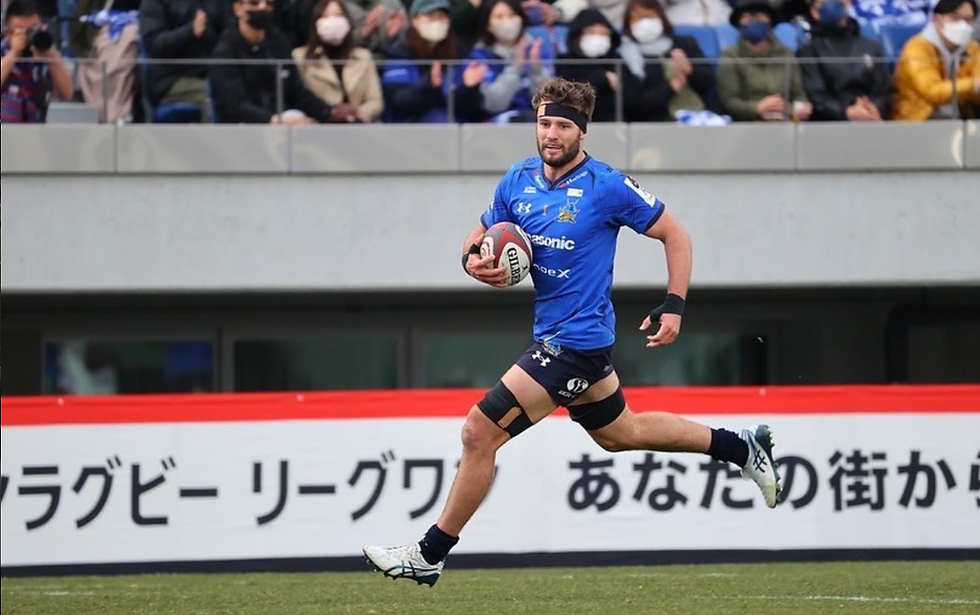Don’t Follow My Path - Hendrik Tui Warns Young Players
- Mark Pickering

- Aug 27
- 3 min read
Former Brave Blossoms star Hendrik Tui has issued a stark warning to young foreign players who are keen to follow his path by moving to Japan to study and pursue a pro career.
Urayasu D-Rocks utility forward Tui, 37, was one of Japan’s heroes at the 2015 World Cup when they produced the biggest upset in the game’s history by beating South Africa in Brighton.
The Mangere, south of Auckland native, who has won 47 caps for Japan and represented his adopted county at the 2019 World Cup, arrived in Japan in 2007 on a rugby scholarship and helped Teikyo to win back-to-back University titles.
After graduating, Tui turned pro with Saitama Wild Knights in 2011 and was fast-tracked into the Japanese national setup just a year later after qualifying on residency grounds.
Now, after 14 years in the professional game - which has included two years at the Reds, a short spell with the Sunwolves and an 11-year stay at Suntory Sungoliath – the former Top League winner reflected on the lessons he’s learnt ahead of his second season at Urayasu.
“Back in 2007 to 2011 I went to Japanese University on a Rugby Scholarship, which ultimately set me up to play professionally for the last 14 years and still going,” he posted on social media platform Threads.
“Would I recommend this pathway now to young aspiring foreign rugby players trying to make it in Japan? No!”
Ex-All Blacks and Shimizu Blue Sharks fly-half Lima Sopoaga replied asking why the former Japan number eight would not encourage young players to chase their dreams in Japan.
“If you look at the average age of All Blacks debutants over the last eight years is roughly around 22/23 and most universities in Japan, coaching is not the best, and I believe those years 18 through to 21 are the most important to your career,” Tui replied.
“Four years is a long time, on roughly average monthly allowance of ¥100,000 ($1000) you have to be disciplined, self-motivated and resilient at the tender age of 18/19 in a foreign country learning a foreign language.
Fan favourite Tui, who runs a grassroots inclusivity project called Project J, added: “This is only one person's opinion. Those who do stick it out for the four years, I have so much respect for. You did it!”

University players typically graduate at the age of 21 and 22 and then have to find a League One club and negotiate the step up from what is essentially national level age-group rugby to the pro ranks and the increasingly competitive, star-laden League One which comprises of three divisions.
Japanese University rugby and its role in nurturing talent is a thorny issue, as Brave Blossoms head coach Eddie Jones can attest to with some Universities refusing to make some of their brightest talents available for national team selection.
The Japan Rugby Football Union (JRFU) will be keen not to get involved in that issue but Japan Rugby League One (JRLO), the body that runs the pro game in Japan has acted to increase the professional playing opportunities for homegrown players from the 2026-2027 League One season.
Japan’s player classification system will be overhauled with a renewed focus on Japan-born players in order to strengthen the domestic talent pool and the national team.
All players are currently registered in Category A (Japan-qualified), Category B (Potentially Japan-qualified having not represented another nation) or Category C (capped Test player for a county other than Japan).
A minimum of 11 Japan-qualified players must be included in a team’s 23-man matchday squad while a maximum of three Category C players can be selected.
From the 2026/2027 season, Category A will be split into A1 and A2 with caps for Japan and years of education in the country among the new considerations for deciding which of new sub-categories a player falls into.
Captain Michael Leitch, for example, will be in Category A1 as he meets the 30-cap requirement while Super Rugby-bound Warner Dearns, who has 23 caps, would be in A2.
Clubs must have at least eight A1 players on the field with long-time internationals such as Lomano Lemeki, who has 20 caps and represented his adopted country at two World Cup tournaments and an Olympics – set to move from the current Category A to the new A2 classification.
Such players could see their playing time reduced with clubs having to shuffle players around and reduce the overall number of foreign players in their squads to meet the new rules.

The arduous path of Hendrik Tui still exists but the road from being a dream-chasing foreigner in Tokyo to carving out a pro career in the country has more drawbacks than ever and its success stories will dwindle in the coming years.




Comments